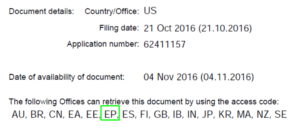![]() On June 1, 2018, the Danish Patent and Trademark Office (DKPTO) will become an Accessing Office in the DAS system.
On June 1, 2018, the Danish Patent and Trademark Office (DKPTO) will become an Accessing Office in the DAS system.
Continue reading “Danish patent office will soon be an Accessing Office in DAS”

Bluesky: @oppedahl.com
![]() On June 1, 2018, the Danish Patent and Trademark Office (DKPTO) will become an Accessing Office in the DAS system.
On June 1, 2018, the Danish Patent and Trademark Office (DKPTO) will become an Accessing Office in the DAS system.
Continue reading “Danish patent office will soon be an Accessing Office in DAS”

Update: I have heard from WIPO that this was a temporary thing, as part of the testing for EPO becoming an Accessing Office. WIPO has now finished the test and the Certificates of Availability as of today no longer mention EPO.
It is still planned that EPO will commence its participation in DAS in the second half of 2018.
Neither EPO or WIPO has yet announced it, but I am delighted to be able to report that EPO is now an Accessing Office in the DAS system. Continue reading “EPO is [not yet] an Accessing Office in DAS”
It’s time to register for this PCT Seminar which will take place June 13-15 in Westminster, Colorado. One reason to register now is that the hotel guest room block will be available only until May 22. Another reason to register now is that coupon code “blog18”, which gives you an extra $100 off the registration price, expires May 22.
Still another reason to make plans now, if you will be flying to Colorado for the Seminar, is that you will want to make your air travel reservations. Probably you would want to arrive at least as early as June 12.
If you’re on the fence and have not yet decided whether or not to attend the Seminar, I invite you to take a look at these handwritten comments from people who attended a recent Seminar that I presented.
It has been announced that on June 1, 2018, the Netherlands Patent Office will join the DAS system. This is of course welcome news, and this will bring the number of DAS participating Offices to 18.
Among the IP5, conspicuously absent from DAS is the European Patent Office. EPO has promised that it will join DAS by late 2018.
Among the ID5, conspicuously absent from DAS is the European Union Intellectual Property Office. It is hoped that EUIPO will join DAS soon.
With regard to the USPTO, the PDX system provides some of the same functions as DAS. If between some pair of Offices (for example US and CN or US and KR) there is both a PDX relationship and a DAS relationship, the PDX relationship trumps. As between DAS and PDX, DAS is to be preferred. It permits more effective troubleshooting by the practitioner and it is more secure. Thus it is hoped that USPTO will soon pull the plug on its PDX relationships with CN and KR, thus permitting DAS to be employed instead.
It is hoped that more and more Offices will participate in DAS with respect to design applications. USPTO has indicated that it will commence participation in DAS as a depositing Office for designs Real Soon Now.
Attend a 2½-day live in-person Patent Cooperation Treaty seminar in Colorado, made possible with generous support from the World Intellectual Property Organization (WIPO). Book by May 22 to get this $699 registration price. To find out more, or to register, click here.
Readers of this blog are invited to use coupon code “blog18” to get an extra $100 off the registration price. Please note that this coupon expires May 22.
I will be teaching a webinar on Tuesday, May 8 about PDX and DAS. Attend this webinar to learn about PDX and DAS or to reinforce what you already know. This program will be of interest to anyone who works on inbound or outbound filings, whether Paris-based or PCT-based or Hague Agreement-based.
To learn more, or to register, click here.
 Will you be in Seattle around May 17-18? Maybe you will be there because you are attending the INTA annual meeting. Maybe you will be there because you are attending the AIPLA Spring meeting.
Will you be in Seattle around May 17-18? Maybe you will be there because you are attending the INTA annual meeting. Maybe you will be there because you are attending the AIPLA Spring meeting.
Then you might consider attending an EPO meeting that will take place. Continue reading “Life sciences patent seminar in Seattle on May 17 and 18”
A member of the PCT listserv recently posted a question in that listserv:
Hello everyone.
Are there any nuances or limitations to incorporating the content of a provisional application by reference in a PCT application (other than, I believe, including such statement in the request and the requirement that the application disclosure to be incorporated is a valid priority application)? The goal is to preserve the less important disclosure of a somewhat lengthy provisional application for use later on, if needed, even possibly after filing national applications. I plan to trim much of the provisional app disclosure in the PCT application to save costs.
Also, are there time limits or deadlines to actually add the material to the current application from the previous application that was incorporated by reference? I am sure this is country specific. But, any general input would be appreciated.
The general answer is “don’t try to incorporate by reference in a PCT application”. Continue reading “Incorporation by reference in a PCT application?”
The ePCT system has a very helpful feature which permits you to see a preview of what will eventually be the first page of your published PCT application. This feature was mentioned in an article in the Practical Advice section of a recent issue of the PCT Newsletter. I am delighted to be able to tell you that the article mentions a mistake made by yours truly and the way I fixed the mistake. Continue reading “Using the PCT Publication Preview feature”
If you try hard enough, can you think of some activity you could pursue for an eight-hour day that would be more fun than spending that day with, say, a hundred other people discussing the finer points of the Patent Cooperation Treaty? Yeah, right, loyal readers, you know what I am talking about. It would not be easy to top that! Continue reading “A fun PCT day in Minneapolis!”